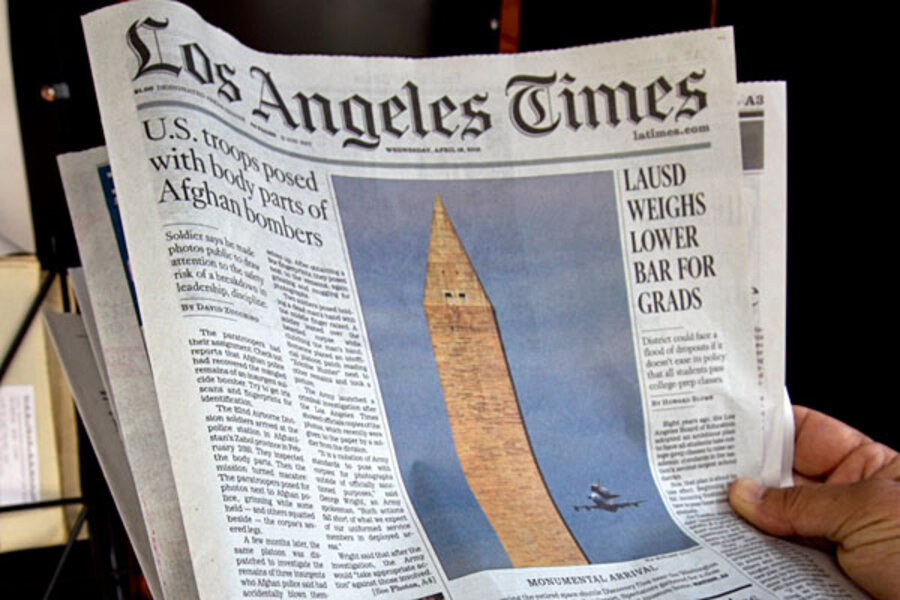Did Los Angeles Times make right call on photos of dead Afghans?
Loading...
| Los Angeles
Photos released Wednesday by the Los Angeles Times – showing smiling US troops in Afghanistan posing with the remains of suicide bombers – are reigniting a debate about the ethics of publishing such photos during wartime.
The question: What is the newspaper’s responsibility to national security weighed against informing the public?
US military officials asked the newspaper not to publish any of the photos, concerned about the possibility of "inciting violence and perhaps causing needless casualties” among US troops abroad, Pentagon spokesman Capt. John Kirby told the Times.
Times Editor Davan Maharaj responded that the photos "fulfill our obligation to readers to report vigorously and impartially on all aspects of the American mission in Afghanistan, including the allegation that the images reflect a breakdown in unit discipline that was endangering US troops.”
Interviews with media experts and ethicists show that editors faced with such decisions are in a tough, and far from clear position. This is partly because of the graphic nature of the photos.
Two of 18 received photos are published in Wednesday's newspaper, and others are only described. A Page 1 photo shows the eyes-open head of a deceased Afghan insurgent, and one on Page 4 shows soldiers of the 4th brigade of the Army’s 82nd Airborne Division – along with Afghan police – holding up the severed legs of a corpse. US soldiers are grinning in both photos.
Not shown are pictures of two soldiers who reportedly pose holding a dead man’s hand with the middle finger raised, and another with a soldier clutching the hand of a bearded corpse next to other remains where someone placed an unofficial platoon patch reading “Zombie Hunter.”
The Times's Mr. Maharaj notes that the paper chose to publish only a "small but representative selection of the photos."
The graphic nature of the photos is part of their significance, says Ben Agger, director of the Center for Theory in the sociology department of the University of Texas at Arlington.
“The war in Vietnam ended because US journalists depicted grotesque death, which turned Americans against the war and drove [President] Johnson from office," he says via e-mail, suggesting that today's photos could have a similar effect on the Afghan war.
Backing the Times decision is Robert Steele of The Poynter Institute, a school in St. Petersburg, Fla., that aims to promote quality journalism.
“The Times made a thoughtful, deliberate, and justifiable decision to publish those images,” he says. “They make a justifiable case for the journalistic purpose in publishing those photos. I believe they honored the ethical principle of revealing the truth as fully as possible.”
Part of the Times's purpose apparently comes from the motivations of the soldier who gave the paper the photos. He said he wanted to draw attention to the safety risk of a breakdown in leadership and discipline. He notes that virtually all of the soldiers in the photos had friends who were killed or wounded by homemade bombs or suicide attacks. “They were frustrated … their buddies had been blown up by IEDs. So they sort of celebrated,” he told the Times.
But other experts say the Pentagon had a compelling case.
"Printing the photos is ill-advised because they show American soldiers in a negative light, are inflammatory, and will speed to the Middle East virally on the Internet, endangering the lives of other solders," says Sally Mounts, president of Auctus Consulting Group, a public relations strategy firm.
“In anyone's mind, posing with dead bodies looks suspiciously like gloating over dead bodies. People take pictures of events they are proud of and want to remember," she adds. "Any soldier who wants to remember the killing he did is not exactly a poster boy for the American ideals we're trying to further in the Middle East."
The Pentagon has stressed that point. The conduct “most certainly does not represent the character and the professionalism of the great majority of our troops in Afghanistan,” Captain Kirby told the Times.
As a result, Ms. Mounts says, the L.A. Times “action is at worst disingenuous and at best unethical. Does the L.A. Times seriously think their need-to-know policy trumps the cost of retaliatory fallout? If even one life is lost as a result of these photos, it is an appalling and thoroughly preventable tragedy.”
For his part, Doug Spero, an associate professor of mass communication at Meredith College in Raleigh, N.C., is torn. He was once a news director and a reporter covering military installations, which gives him some sympathy for the Pentagon's position.
“If I received a call and [military officials] made any practical or logical sense on why this would endanger troops – and the story value wasn’t that high – I’d cooperate. Not only for future relationships, but if there is going to be an error made, I’d would rather it be on the side of national security and pro-defense," he says. "Sometimes there is a higher calling. This is a very sticky issue, and journalists need to evaluate each situation individually without any prejudice.”







